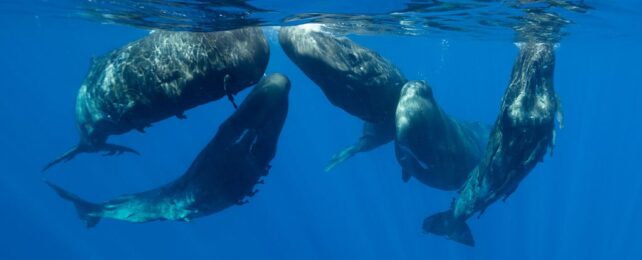A leading expert on sperm whales has gathered the evidence and shown that the biggest-brained animals on Earth form large and complex clans with unique dialects and behaviors.
Using some rough calculations based on sperm whale populations, Hal Whitehead from Dalhousie University in Canada estimates that many of these clans number in the tens of thousands.
Seven clans alone live in the North Pacific, according to recent underwater acoustic data, and yet despite their shared genes, it's extremely rare for these groups to interact.
When traveling, a clan of sperm whales can sometimes take an hour or more to make a simple 90-degree turn, which could indicate some level of 'democratic' decision-making. Forget herding cats; talk about herding sperm whales.
"In many respects the closest parallel may be the ethno-linguistic groups of humans," writes Whitehead about the sperm whale clans.
"While the two species and their societies are very different," he adds, "the existence of very large-scale social structures in both sperm whales and humans supports some primary drivers of the phenomenon that are common to both species."
Such drivers could include cognition, cooperation, or culture, which Whitehead points out "are not purely products of human exceptionalism."
Similar to our own species, Whitehead says the sperm whale is also "an animal of extremes".
It is the most unique cetacean out there, differing significantly from whales, dolphins, and porpoises in its genes, physicality, and behavior.
Not only does it have the biggest brain in the animal world, it also has the largest nose, which it uses as a sonar to detect prey and the clicks of other whales.
Similar to sperm whales, orcas also live in matrilineal social units with unique dialects, and yet these black-and-white creatures only gather into clans of a few hundred or thousand. There are also signs of genetic divergence among orca clans, indicating possible subspecies.
Sperm whale clans are much bigger and seem to be culturally, not genetically, driven. Within each clan, scientific surveys suggest there are smaller whale units of about ten females and their offspring.
These tightly knit communities travel together, look after each others' infants, even feed them, and defend each other from orca attacks. They also form larger groups with one or two other units.
Male sperm whales are decidedly lacking. As teens, they leave their units and head to colder waters further north, displaying the greatest sexual segregation of any species on Earth.
Despite such exceptional features, Whitehead says only about a dozen scientists in the world are currently studying the social structure of sperm whales, and this field of study only began recently.
Whitehead's own research started in the Galápagos Islands in the 1980s and 1990s. It was then that he and his colleague, Luke Rendell, first noticed that some clicking patterns made by sperm whales (called codas) fell into two vocal 'clans'.
Both clans used coda patterns that were unique to their group, and they rarely communicated with the other clan.
Males return to the warmer waters to breed in their late 20s. Genes suggest that females remain in the same clan but may mate with males from another clan.
"Presumably, then, the characteristic dialects are learned from the mother and other females in a young sperm whale's social unit, as well as perhaps from grouped members of other social units, which will be of the same clan," explains Whitehead.
In 2003, Whitehead and Rendell collected acoustic data from 23 locations in the Pacific Ocean and found similar sperm whale clans had formed near Chile, Ecuador, Tonga, New Zealand, and Japan.
Later, sperm whale clans were identified off the coast of Mauritius in the Indian Ocean and in the eastern Caribbean of the Atlantic Ocean.
"The clans seemed to be a fundamental part of sperm whale life," writes Whitehead in his newest paper.
"Because two or more clans are frequently found in the same area with basically the same environment, and nuclear genes are well mixed between clans, culture is the only tenable explanation for the differences between clans."
Whitehead isn't the only sperm whale researcher to suspect these clans are based on a learned culture, but more research is needed.
There is still much left to learn about these exceptionally clever creatures.
The study was published in the Royal Society Open Science.
